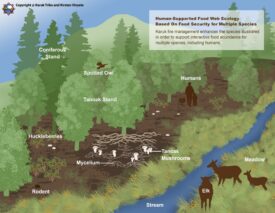Family forest owners steward nearly 6 million acres of forestland across Oregon and Washington—an area nearly the size of Vermont, or of 25 Mount Rainier National Parks strung together. All told, these landowners hold nearly one-third of privately owned forests in the two states. Across the United States, family forest owners (which the US Forest Service defines as private, individual or family owners), manage a full third of all forests.
Together, these landowners control one of the country’s biggest opportunities for carbon drawdown.
Across the United States, family forest owners manage a full third of all forests. Together, these landowners control one of the country’s biggest opportunities for carbon drawdown.

Ecological climate-smart forest management harnesses the environmental and climate benefits of forests while maintaining timber output. Forest management decisions mimic natural disturbance in the timing and extent of harvests, increasing carbon sequestration, water and air quality, public health benefits, and maintaining wildlife habitats. The practices include extending harvest rotations from industrial standards, selectively harvesting certain trees (as opposed to clearcutting), and retaining wide forested buffers along waterways.
This management style stands in contrast to the more widely practiced types of forestry which optimize financial outcomes, basing management decisions on economic models that maximize net present value of timber alone. In this paradigm, discount rates drive harvest methods and schedules more than any social or environmental values.
Family forest owners are ideal champions for ecological, climate-smart forest management as the majority of these landowners consistently cite values like recreation, wildlife, aesthetics, and family legacy as primary drivers of their management decisions. These values open many family forest owners to alternatives to industrial-style forest management, which can degrade their forests’ aesthetic and ecological value.
Although carbon markets could offer a way to close the financial gap between production and ecological forest management by paying for the additional carbon stored in climate-smart forests, they currently don’t serve many family forest owners well. The persistently low market price of carbon, coupled with complex and expensive project development protocols and long contracts, make offset projects unappealing to many family forest owners.
To change this dynamic, offset projects need to provide these landowners with more revenue, either through higher carbon prices or lower development costs. For many family forest owners, practice-based incentive programs focused on carbon sequestration may provide a simpler near-term way to reward landowners for the provision of ecosystem services to the public.
Carbon markets haven’t worked for most family forest owners
Carbon markets allow carbon emitters to offset a portion of their greenhouse gas pollution by purchasing credits from projects that either reduce emissions, or permanently sequester additional carbon beyond business as usual. To achieve actual climate benefits, carbon stocks and flows must be carefully measured, modeled, verified, maintained, and monitored. Forest carbon projects are among the most popular credit producers, but measuring forest carbon is complex, and project development and monitoring costs can run into the hundreds of thousands of dollars.
These costs, combined with the persistently low price of carbon, mean that only large carbon projects can cover development costs and still generate revenue. In the last three years, typical voluntary market offsets from forestry and land use projects averaged between $3 and $6 per ton of sequestered carbon dioxide equivalent. Regulatory markets, like California’s cap and trade system, offer slightly higher prices, but still not enough to make small projects pencil. At this rate, forest carbon projects need thousands of acres to be financially feasible. The average US family forest owner stewards around 30 acres; potential income from carbon projects this size doesn’t even begin to cover development costs.
Over the last two decades, many organizations have experimented with strategies to overcome the high development cost of forest carbon offset projects. Programs have helped forest owners cover carbon inventory fees, aggregate their holdings with other owners to spread expenses, and estimate their site-specific benefits and potential income from a variety of management plans.
While these efforts have made progress toward lowering costs and broadening participation in these projects, the low price of carbon and high price of timber still mean that few forest owners would opt to sacrifice thousands of dollars per acre to choose carbon over timber.
As a result, only a limited, self-selecting group of landowners find forest carbon projects attractive and feasible. Many family forest owners are land rich but cash poor, and while they may not depend on their forest for annual income, many view their stands as emergency savings accounts, available to hedge against unexpected expenses. While carbon offset projects allow some harvesting, owners must maintain all the carbon they’ve sold. In other words, for the duration of the contract (which typically stretches between 40 and 100 years), owners can’t liquidate their timber if they need an infusion of cash.
Despite the increasing demand for carbon offsets, particularly in voluntary markets, carbon prices have remained persistently low over the last 15 years. Until the market price of carbon increases—either as a result of state or federal level carbon pricing or growing demand, forest carbon offsets may do little to shift the forest management at a scale large enough to reduce atmospheric CO2 concentrations.
Two innovations could offer new pathways into markets
Several innovative companies are pioneering project protocols using new technology that could reduce project verification costs and make offset agreements more accessible to family forest owners.
One innovation on the horizon is that of remote sensing technology. High-resolution satellite data could reduce the need for on-the-ground carbon measurements, slashing inventory and verification costs. Several companies are experimenting with remote measurement tools, including Pachama and SilviaTerra.
Carbon rental programs may also offer an appealing alternative to traditional offset projects. Rather than entering a contract that limits harvests for up to a century, rental programs pay landowners to delay harvest for a short period of time, perhaps as little as one year, incrementally moving the economic dial toward longer rotations. The theory is that by extending the average harvest rotation across a landscape, total carbon storage increases. Some companies, like SilviaTerra, are testing this approach.
While carbon rentals may be an effective way to lengthen harvest rotations on industrial forestland based on economic net present value calculations, these owners are also constrained by supply agreements, milling infrastructure, and product demand that may preclude long-term participation. Complicating the effectiveness of this approach, many family forest owners do not manage on strict harvest schedules. They may be more than willing to put off a harvest for a year or two if timber prices are low, foresters and loggers aren’t available, the weather is bad, or it’s simply not a good time for them.
This brings up a continuing issue in the offset world around the concept of additionality. Is it enough to show that someone is managing beyond what is legally required or economically optimal, or should offset projects have to prove a change in behavior? While the latter may be next to impossible to prove, issuing offsets based strictly on the former may not represent real carbon gains.
The strength of the rental approach may be that it pays owners for economically additional carbon, without making assumptions about future events. The strength of long-term offset projects is that they legally ensure forests will be conserved and continue to sequester and store carbon, as well as deliver other ecosystem benefits, well into the future.
Carbon rental programs have yet to be used on a wide scale. SilviaTerra awaits verification of its remote sensing measurement protocol by an established carbon registry. If the method proves sufficiently accurate, it could reduce the cost of carbon inventory and verification, and the protocol could eliminate the hurdle of long contracts, reducing two of the barriers small forest owners face in accessing carbon markets.
Practice-based incentive payments offer another way forward
Publicly funded incentive payment programs offer an alternative to the market-based model. If explicitly focused on carbon, these programs could sever the direct ton-to-ton linkage between polluters and forest carbon storage, and pay forest owners to adopt practices proven to sequester additional carbon and provide ecosystem services such as cleaner water and air. Incentive programs would give these landowners a means of monetizing the ecosystem services they provide without the lengthy and expensive inventory and monitoring required by offset markets.
Voluntary practice-based incentive programs already enjoy wide subscription and bipartisan support with a long history in US Department of Agriculture (USDA) conservation programs. Congress currently allocates $6 billion annually to incentive-based conservation programs via the Farm Bill. Landowners who choose to participate commit to adopting best practices for conservation, water and air quality, soil health, or ecosystem protection. In return, they receive payments, which vary by program and estimated environmental benefits.
 Most of the largest existing federal programs focus on agriculture, with less money available for forest projects or climate benefits in either sector.
Most of the largest existing federal programs focus on agriculture, with less money available for forest projects or climate benefits in either sector.
Several Pacific Northwest organizations have outlined practice-based forest carbon incentive policies that could fill this void. (For examples, see reports from the Pinchot Institute and Ecotrust.) Programs could scale payments based on carbon sequestration estimates from COMET-Farm, the USDA’s recently developed open-source tool for land-based carbon flows. Projects that offer bundles of ecosystem services, like water quality and wildlife habitat protection, could receive additional subsidies and priority.
Though COMET’s carbon estimates can’t be used to issue offsets, they may be accurate enough to count toward jurisdictional emission reduction goals. To support these efforts, the USDA could increase COMET’s statistical accuracy by boosting funding for the national Forest Inventory Analysis, which informs the tool’s estimates.
To attract widespread participation, a publicly funded forest carbon incentive program will need to accommodate family forest owners’ unique priorities. Short contracts, preferably less than 30 years, could help attract owners wary of long contracts, lost flexibility, and penalties for early withdrawal. Dialing in the correct price point will also be key; forest owners could participate in price negotiations via reverse auctions, as in other USDA conservation programs. And finally, one-on-one interaction with local natural resource professionals can provide a greater enrollment incentive than even a financial benefit. Partnering with the Forest Service’s Forest Stewardship Program (FSP) could provide opportunity for personalized forest management planning.
Family forest owners could lead on climate-smart forestry—if we figure out how to support them
The coastal Northwest is home to some of the most carbon-rich ecosystems on Earth, and climate-smart forest management could double the carbon in the region’s working forests without compromising long-term timber production. Family forest owners may be best positioned to lead this new management paradigm which values carbon on the stump.
The coastal Northwest is home to some of the most carbon-rich ecosystems on Earth, and climate-smart forest management could double the carbon in the region’s working forests without compromising long-term timber production.

But existing mechanisms to incentivize carbon storage often don’t meet family forest owner needs. While public incentive programs could provide an immediate means to drive climate-smart forestry adoption, they can’t address a core economic issue at the heart of global climate change—that is, the externalized cost of greenhouse gas emissions. On the other hand, though a carbon market could address this market failure, it requires precise accounting standards to make carbon a uniform and tradable commodity. The current high cost of accounting, coupled with low carbon prices, shuts many landowners out.
The most politically feasible path forward may lie in a combination of the two. Farm Bill incentive programs could provide a near-term solution to boost forest carbon stocks. Even as these incentives engender a shift toward more climate-friendly forestry, markets may become more widely accessible via quickly evolving measurement technologies that reduce the cost of market entry, or an increase in the price of carbon, making more projects financially feasible.
Momentum for federally funded forest carbon incentives appears to be growing, with members from both sides of the aisle in the US House and Senate signaling support for funding climate-friendly land management practices. In addition, the USDA’s 2021 transition team released a report in November pledging a commitment to a national carbon bank, which could support federal funding for climate-smart land management practices. These could be the first steps toward the shift in forest management our climate needs.
Acknowledgements
Data on family forest ownerships in the Pacific Northwest comes from an information request to the US Forest Service’s Forest Inventory Analysis data services department.
Many organizations in the Pacific Northwest and beyond have worked with family forest owners interested in managing their land for carbon. These groups include Ecotrust, the Northwest Natural Resource Group, Oregon Small Woodlands Association, and the Pinchot Institute for Conservation. Their work and findings formed the basis of this article.
Josh Fain is the Forest Carbon Program Manager at The Pinchot Institute for Conservation and is currently working to connect local businesses and land trusts through The Appalachian Carbon Exchange. He can be reached at josh.fain@pinchot.org.
Thank you to Jade Chan for editing.












Miguel Pérez-Gibson
Great article. I learned a lot. My daughter and son-in-law have 140 acres of forest land and are interested in managing their forest to help reduce carbon. I want to add that by extending the rotation age, timber volume per acre is increased. Given that in general forests continue to add net positive growth (mean annual increment) up to around age 90, we can have both, carbon storage and an increase in timber volume. Never mind that we will also increase the quality of the timber products harvested including appearance grade quality lumber. What we need is a revenue source that can supplement the reduction in net present value.
Jim Fairchild
I’d like to be constructive, but as a FSC forest land manager doing uneven-aged douglas-fir management with all stand ages 75+, I’m more than a little concerned that I may be expected to demonstrate a further change in behavior to qualify for forest carbon additionality. My group certifier (spans OR and WA) has yet to demonstrate a commitment to its members towards investing in carbon market opportunities, so I’m left to wonder if progressive non-industrial forest landowners will pay their own way out of 20th century forestry thinking. I bet I’m not alone in this here in Oregon, where forestry concepts and practices from the 19th century still hold sway.
To Miguel, please remember that CMAI based on breast height does not account for total tree growth rate. Douglas firs continue putting on their most board feet/year for another hundred years AFTER they hit CMAI measured at dbh. You can roughly double that bd.ft. above-ground carbon for the accumulating below-ground carbon contribution.